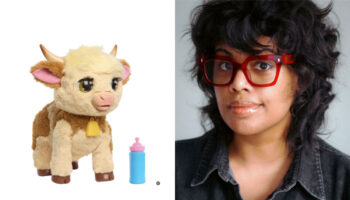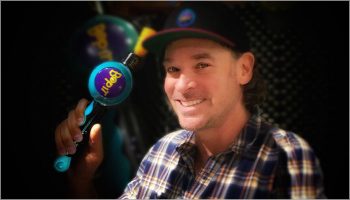Tony Serebriany on pitching in person, The Op’s process – and the right time to follow up

Terrific to see you, Tony…
Great to see you too Deej, feels like far too long!
Words I rarely hear back! Thank you! What’s been keeping you busy?
A lot’s been keeping me busy, both at work, outside of work and creatively… For work, we’ve just entered 2023 with some exciting new projects and initiatives, much of which will be announced in the coming months. Also, this past year one of our company founders – Dane Chapin – stepped back in as CEO after an interim away from the day-to-day running of the business. Therefore, this past year’s been full of change as we help get Dane back up to speed and begin to implement some of his plans.
We’ve also expanded our Inventor Relations team to include Pat Marino – the Director of our Hobby Games business, and Tina Sandusky – Manager of our Family and Party games business. Between the three of us we’ve also updated our product-submission process, giving us the ability to share and better focus the scouting… All very exciting. We’re also running a ‘Road To Gen Con’ Tournament in support of our recently launched game, Disney’s Sorcerers Arena game – so our Marketing and Sales teams are working hard to help take The Op in some fun new directions.
Strewth! That IS a lot! And the personal update?
Since our last chat, we’ve been blessed with two granddaughters to our family, Ozzy Caroline and Bobbi Delphine. We’re also very fortunate that, for the moment, our daughter Fiona, her husband Chris and their two babies are living with us, as is our other daughter. We’re getting a lot of great time with the family!
Lovely! Lovely names… And caroline and delphine are both playable in Bananagrams, should it ever help!
Is that right?
Yes – a caroline is an old unit of currency; delphine means ‘relating to dolphins’. Don’t say that isn’t interesting!
It is!

You also mentioned being busy creatively?
Yes! I’ve just completed a series of evening glass-blowing classes at a local community college. It’s a hobby I’ve had for years, but haven’t had access to a studio in some time, so this has been very fulfilling. With these joyful things, we’ve also had some loss in our family since we last spoke… My mother-in-law passed away in December of 2021, and my father passed away in July of 2022.
Oh, Tony; I’m so sorry. I can’t imagine how awful that is.
Yes; not easy. I will say that having the extended family in the house has certainly helped with all the grief.
Purely by coincidence, I was going to ask about your family. I meant to ask you last time: how should people pronounce your surname?
Thanks for asking! It’s pronounced Sara – like the name; brie – like the cheese; “on” – like a light… Then the letter E.
Sara-brie-on-E… And where’s that from? Does it have a meaning?
It hails from family that was originally from Lithuania and the Ukraine, and has a meaning of either ‘silversmith’ or ‘made of silver’.
And this was your father’s name?
Kind of! My father, who was born in Belgium, originally grew up speaking French… So to him the pronunciation had more of a French cadence to it… However, based on the origins, it was likely more Slavic sounding. Being Jewish, my father and his family fled Europe during WWII – which is another story in and of itself – and, thankfully, they eventually made it to America.

Bloody hell, Tony… I’m glad I asked!
During college, my father found it was increasingly difficult for the American population to pronounce and spell his name. Since he was going into a public-facing career, he felt inclined to change his last name to something easier. And since the meaning of the name relates to silver, he chose Sterling, like sterling silver…
So did you grow up as Tony Sterling?!
I did! Tony Sterling… Hearing this story while growing up, though, I thought it’d be great to sometime reclaim the family name. Then, when I was in college, my darling wife gave me everything needed to make this happen. With that, myself, our daughters and now granddaughters are likely some of the only Serebriany namesakes in the US.
That was a rollercoaster! We could wrap this up right now and I’d be happy with it! I’ll press on though. Okay… Last time we spoke, you gave us some advice on pitching to you virtually…
Yes!
It’s excellent; people can read about that here… Happily, though, it looks like we’re doing live pitches again this year as well. That being the case, is there any advice you’d add to what you said last time?
I think the last time we chatted there was some good information. A couple of key things still stand out to me, though. First of all, I’d say use your time wisely – especially when in person, because both parties are likely to be in back-to-back meetings… So time management is key. Therefore, ask if the person or company you’re pitching to is looking for any particular type of game, or what they’re not looking for, as this can help shape your time together.
Right; narrow it down if it isn’t clear from the wishlist…
Secondly, I’d add that it’s important – as we increasingly migrate back to in-person meetings – to be mindful that some of the time together may be spent on reconnecting, as we haven’t seen each other in some time… Since relationships are so important, this’ll be a good time to re-establish this. And lastly, don’t forget to cater your pitch to the company and person you’re presenting to. This is both in the mix of products shown, but also in how you pitch.

How so?
Well, some scouts want to play all the games you show, or at least a few turns. Some just want to know how you win; some want to know the objective of the game or the various strategies of play… Some want to know how the experience of playing the game will make people feel – and some want all of the above.
And when an inventor shows you an idea on which you’re not much keen, Tony, what do you say? With what charming, tactful and kind words do you break hearts and end dreams?!
Ha! This is a funny question because if you ask any toy or game scout, most will agree that we say “no” to ideas way more than we ever say “yes“. With that, though, I believe it’s important to be respectful and kind with the feedback given as every designer has spent hours of their time developing these product submissions.
Right…
And since honesty is the best policy, if it’s clear to me that the idea isn’t a fit, I often share just that. Also, sometimes – if I like the item but it isn’t right for The Op – I may recommend another publisher or two as a suggestion to pitch to. There are so many good game ideas being developed, many more than will ever get published… So, sometimes, when we pass on a good idea for one reason or another, I’ll also share that I look forward to adding this game to my collection when it releases.
Honest and kind… And out of curiosity, how often do you see something that’s not quite right and – in the room – make suggestions about improvements?
This depends on the item, the person pitching and the meeting. I say that because sometimes it’s clear very early that something isn’t a good fit, so it may be a quick pass, and therefore not much time gets dedicated to thinking about how to tweak it or improve it.

Makes sense.
That said, if we see something that piques our interest, by nature of the discussion and questions asked during the meeting, there may be some back and forth. That might be about how the designer got there, or did they try this or that. By default, we’re then into the weeds of a development-style evaluation and discussion. Sometimes asking questions can lead into improvement suggestions without trying to do so.
Also, when a publisher brings in a submission, there’ll usually be quite a bit of development work – not all of which is done in consort with the designer. However, in pitch meetings, there are times where we’ll ask, “Can we try this again but tweak this aspect?” And even if we pass on the item, this feedback is great for many designers because they just got a potential opportunity to improve a gameplay experience – regardless of whether or not they keep or use these suggestions.
That’s a very thorough answer, thank you… I know some inventors can get a bit – well, disorientated, I suppose, so I think it helps to know what you’re thinking. And the opposite question, then… When you see an idea you like, how do you move ideas forward?
That’s a tough one because it’s a bit different depending on what type of game it is, and where we are in our development cycle. One of the first things we do if we like an item is to request more information…

Such as?
Such as sell sheets, a sizzle reel or how to play videos… Also copies of the rules and maybe even a prototype. Depending upon the type of game, Hobby vs Family or Party game, will determine which team reviews the submitted items, and what their process and evaluation criteria is. If there are games that make it through this initial review, we’ll request a prototype or Print and Play files if we haven’t already done so. That lets us fully play through the game a number of times to adequately evaluate the experience.
Once a submission’s gone through our evaluation process, and there’s interest in the item, the team lead presents it at our weekly development meeting. There, a broad group of department heads and other stakeholders gather to discuss new product ideas and other projects at various stages of development, and this is the time to determine next steps on any item.
So, hopefully, those meetings – if I’m hearing you right – can gain a consensus to move the idea forward to the next stage?
Right. Depending on the scope of the project, time in the development cycle and type of feedback the group offered, we’ll determine if we move to option or license an item. From that point on, it’s given a time frame and slots into our development cycle, or scheduled for further playtesting and evaluations if necessary.
Brilliant! So thorough; I’m loving this. You mention optioning… Options seem a wee bit hit-and-miss these days. Why might that be do you suppose?
When you say options seem hit-and-miss, are you suggesting that not many publishers are offering them? Or that – when offered – they don’t pan out to a licensing deal?
Good question. I actually meant the former, but feel free to speak about both!
Well… Either way, publishers might be hesitant to risk time and money unless they’re completely certain about an item. That said, The Op does occasionally offer options, especially if there’s a broader amount of playtesting, production evaluation or costing exploration to do. It would only be fair to the designer that we ask for some exclusivity while we go through this exercise as the last thing we’d want is another publisher to go to contract on a game we’re still seriously evaluating.

Right. Because some designers will be pitching that one idea to lots of people…
Exactly, while others will pitch an item to one publisher at a time. Since we receive so many submissions, though, an option may occasionally allow us more flexibility for evaluation and consideration against other items in review. With that said, just because we may go to option on an item, it doesn’t guarantee we’ll go to contract… In some cases it has meant that, and in others it hasn’t.
Oh, gosh; no… I wouldn’t want anyone to infer that an option is tantamount to a green light. Let me ask you this, Tony: given how busy inventor-relations people are, how long should designers wait before following up with you?
Time is the biggest challenge for any toy and game scout… Ideally, we would know our initial take on a submission within 30 days. However, since our teams are also the leads on the development work for their games, the staff is juggling a lot of various job responsibilities. As we’ve recently expanded our Inventor Relations team, there are now more shared responsibilities with the reviewing and follow-up. For that reason, the goal is to be able to get back to designers within 30-60 days, regardless of our decisions.
And the new product-submission process should help there…
It should! Our new online submission portal gives designers an ongoing ability to submit items for review without the need for a given trade show or specific time in the year. The system’s set up to notify each of us internally when new items have been submitted and/or assigned into each of the teams.
This kicks off the ability for the teams to begin their review process, and we’ll know who the designer is, and how to contact them with questions or follow-up needs. Once communication’s been established, a designer would be welcome to reach out and ‘check in’ on their submission sometime after the 30-day mark if they haven’t already heard back from us.
That said, don’t expect to hear back from anyone right away, or even within the first week of submitting an item. Unless you’ve gotten an offer from another publisher, and you’re wanting to reach out and let them know that the item’s no longer available for license, resist the urge to reach out and ask how the review process is going within the first few weeks.
Makes sense. One last thought on this… How helpful is it for you to get feedback from inventors on how THEY felt a pitch went?!
I’ll sometimes ask this question, especially if the pitch was fabulous! Also, if I felt like there were major questions I had based on a poor pitch, I may ask the same question, but with a slightly different goal and feedback to share.
Perfect. Finally, then, the last time we spoke you said the most interesting item on your desk was a GeoBender Cube. Is that still the case? Has it been usurped? If not, what is the NEXT most interesting thing?
Oh! Well… While the GeoBender Cube is still in my office, one of the newer items that is on my desk is a personally made business card from Mandy and Jordan Goddard of Indy Toy Lab, the designers of the game Lotus.
Go on…
These two highly creative folks made a card that has a single digital die roller as part of the card… Complete with battery, LED lights, transistors, power switch and ‘Roll Dice’ button!
Sounds amazing! Good answer, Thank you so much again for joining me. And again, my condolences for your recent losses.

–
To stay in the loop with the latest news, interviews and features from the world of toy and game design, sign up to our weekly newsletter here






















